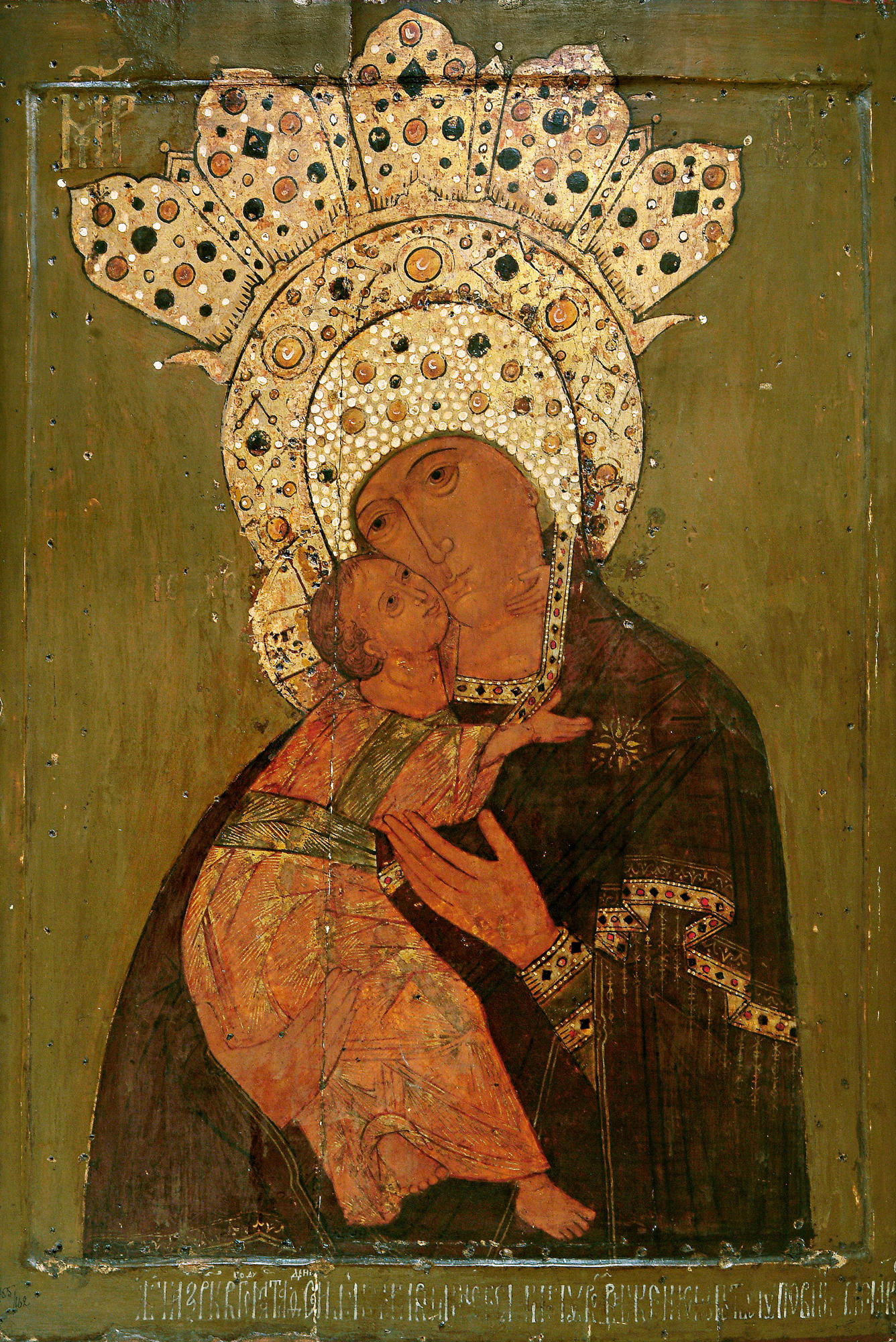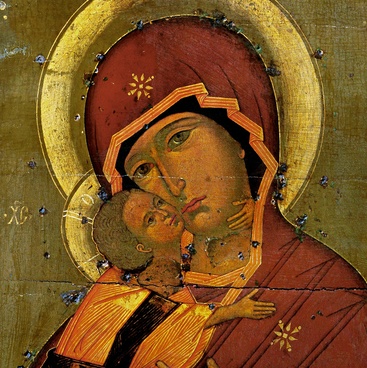The icon depicts the Virgin Mary of Vladimir. The iconographer Roslavov created it in 1614. The image of the Holy Virgin is written in the traditions of the Byzantine icons of the first third of the 12th century. According to legend, the first image such as this was created by Luke the Evangelist during the life of the Mother of God. It was then brought from Constantinople to Vyshgorod located near Kiev. In 1154, Grand Prince Andrey Bogolyubsky moved the icon to Vladimir and placed it in the Assumption Cathedral.
By that time the image had already risen to fame for numerous miracles and had been called the Virgin Mary of Vladimir. In 1395, during the invasion of the Mongol conqueror Tamerlane the miraculous icon was transferred to Moscow in order to protect the city. After that, the icon began to be revered as an all-Russian relic and a patroness of the Moscow state. From then on, she is located in the Assumption Cathedral in Moscow.
At the end of the 14th – beginning of the 15th centuries, replicas of this icon began to appear. Subsequently, they spread throughout Russia. These replicas can be divided into several main iconographic variations that were established due to repeated changes in the appearance of the miraculous image.
Composition of the Murom icon dates back to the image of the Virgin Mary of Vladimir, which was painted in 1514. In this type of iconography, the left hand of the Blessed Virgin is raised much higher than the right. On her neck, under the omophorion (enveloping robe), the left arm of the baby Christ is visible. The icon of the Virgin Mary of Vladimir is not quite usual for Murom. Most often there were images of Our Lady of Hodegetria in Murom churches, and this icon belongs to the iconographic type of Tenderness. Its main feature is the image of the baby Christ, who sits on the right hand of the Mother of God and hugs her by the neck, snuggling his mother’s cheek. The heel of the baby’s left foot is turned towards the viewer.
The Virgin Mary of Vladimir is the oldest signed icon preserved in Murom, which has an exact date on it. First name of the iconographer Roslavov has not yet been found in the sources. His other works are unknown. In the inscription to the icon, the only one mentioned is the icon painter, who could be not only a master artist who created it but also a contributor. The artist’s name is not written, only his nickname is indicated. The artistic features of the icon suggest that the iconographer worked in Murom and became a master at the end of the 16th century.
By that time the image had already risen to fame for numerous miracles and had been called the Virgin Mary of Vladimir. In 1395, during the invasion of the Mongol conqueror Tamerlane the miraculous icon was transferred to Moscow in order to protect the city. After that, the icon began to be revered as an all-Russian relic and a patroness of the Moscow state. From then on, she is located in the Assumption Cathedral in Moscow.
At the end of the 14th – beginning of the 15th centuries, replicas of this icon began to appear. Subsequently, they spread throughout Russia. These replicas can be divided into several main iconographic variations that were established due to repeated changes in the appearance of the miraculous image.
Composition of the Murom icon dates back to the image of the Virgin Mary of Vladimir, which was painted in 1514. In this type of iconography, the left hand of the Blessed Virgin is raised much higher than the right. On her neck, under the omophorion (enveloping robe), the left arm of the baby Christ is visible. The icon of the Virgin Mary of Vladimir is not quite usual for Murom. Most often there were images of Our Lady of Hodegetria in Murom churches, and this icon belongs to the iconographic type of Tenderness. Its main feature is the image of the baby Christ, who sits on the right hand of the Mother of God and hugs her by the neck, snuggling his mother’s cheek. The heel of the baby’s left foot is turned towards the viewer.
The Virgin Mary of Vladimir is the oldest signed icon preserved in Murom, which has an exact date on it. First name of the iconographer Roslavov has not yet been found in the sources. His other works are unknown. In the inscription to the icon, the only one mentioned is the icon painter, who could be not only a master artist who created it but also a contributor. The artist’s name is not written, only his nickname is indicated. The artistic features of the icon suggest that the iconographer worked in Murom and became a master at the end of the 16th century.


